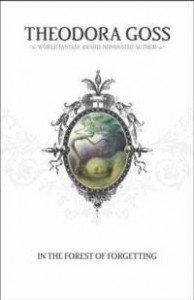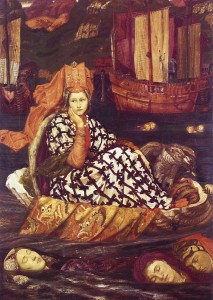 Theodora Goss’ style appeals very much to me, although I’ve found that style tricky to pin down. Her style isn’t as distinct to me as Elizabeth Hand’s, and yet it still feels individualized. The one word I would use to describe her style is precise: every sentence feels exact, as if no word is superfluous or absent. Her writing is poetic, like Hand’s, but in a different way. Her descriptions are spare—she’s not given to detail lists like Hand—and yet the details she does supply are enough to evoke rich images. As I reread Goss’ first short-story collection, In the Forest of Forgetting (Prime Books, 2007; all quotations taken from this edition), I focused on her use of structure, narrative voice, and linked stories. Warning: spoilers to follow.
Theodora Goss’ style appeals very much to me, although I’ve found that style tricky to pin down. Her style isn’t as distinct to me as Elizabeth Hand’s, and yet it still feels individualized. The one word I would use to describe her style is precise: every sentence feels exact, as if no word is superfluous or absent. Her writing is poetic, like Hand’s, but in a different way. Her descriptions are spare—she’s not given to detail lists like Hand—and yet the details she does supply are enough to evoke rich images. As I reread Goss’ first short-story collection, In the Forest of Forgetting (Prime Books, 2007; all quotations taken from this edition), I focused on her use of structure, narrative voice, and linked stories. Warning: spoilers to follow.
The precision I mentioned in regards to Goss’ style also extends to her plotting and structure. In “The Rose in Twelve Petals,” for example, Goss creates twelve sections (to reflect the titular rose), and sectioning is something she does in several stories, like “Professor Berkowitz Stands on the Threshold,” “Miss Emily Gray,” and “Sleeping with Bears.” She also titles each section in these stories, and those titles are mostly straightforward, named after characters in “Twelve Petals” or parts of the wedding ceremony in “Sleeping with Bears.” My favorite section titles—and also the ones that seem most like titles I would use—are in “Professor Berkowitz.” Each section title is poetic and evocative, like “The Sun Rises in an Ecstasy of Brightness” and “The Sea is as Deep as Death, and as Filled with Whispers.” The titles relate—at least intuitively, although usually more directly—with what goes on in the section. Because what happens in the story is so surreal, the section titles also help to underscore that quality. Her use of sectioning, instead of breaking up the flow of the narrative, actually helps to focus the reader’s attention more on what happens in each individual section.
Goss also uses narrative voice in her stories to good effect. In “The Rose in Twelve Petals,” Goss incorporates a number of points of view (one for each section). In contemporary reworkings of fairy tales, writing from a different or unexpected perspective is not revolutionary (poets adapting fairy tales are particularly fond of this convention, writing from the point of view of Hansel & Gretel’s father [Gwen Strauss], for example, or from Little Red Riding Hood’s grandmother [Laurence Snydal]; and Gregory Maguire has practically made a cottage industry of using this convention in novels, as have many other writers). What I like about what Goss has done is that in one story she’s covered just about every possible perspective in the Sleeping Beauty tale, from the witch to the royal parents to the spinning wheel to the hound. Each part builds the complete story. But it’s not just this “post-modern parlor trick,” if you will, that makes the story interesting. Goss not only upends expectations (the witch is not so bad after all, the prince is ineffective), but the twelfth section does veer into post-modern territory, where she invites the readers to imagine their own ending to the story (and thus inducts them into the act of creation): “The rose can tell us [how the story ends], but it will not. The wind sets its leaves stirring, and petals fall, and it whispers to us: you must find your own ending” (22)—and the narrator offers her own non-traditional ending as well. This use of the narrative voice as “oral storyteller” appeals to me as a reader, but as a writer I’ve never felt comfortable using a narrator that addresses the audience directly; to my ear, it sounds false. Perhaps I should try to write something in that narrative voice, to get a better feel for it.
Goss further explores that “oral storyteller” narrative voice with her several first-person narrator stories—“The Rapid Advance of Sorrow,” “Letters from Budapest” (István’s letters, anyway), “The Wings of Meister Wilhelm,” “A Statement in the Case,” “The Belt,” and the communal narrator in “Lessons with Miss Gray.” She uses letter-writing in both “Rapid Advance” and “Letters,” which has the feel of oral storytelling—obviously letters written to a friend and a brother, respectively, will be more conversational than a typical first-person narrator—and yet the letters themselves create more of a remove for the reader because we’re spying on a private communiqué. That feeling of reading someone’s letter over his shoulder, presumably without his knowledge, creates an interesting juxtaposition: we’re invited to read and yet we know we shouldn’t be reading it. Of course, one can argue that illicitly reading someone else’s letter creates a certain frisson for the reader because of the forbidden quality of the reading, and that’s why we’re so intrigued by it (which explains the popularity of Nick Bantock’s Griffin & Sabine books). In contrast, the direct monologues of Mike in “A Statement in the Case” and the unnamed narrator in “The Belt” close the distance for the reader—both speak directly to their listeners, and we—becoming the “you” that is Sergeant Gorski and Madam—are thus addressed directly. The reader then is placed more immediately in the narrative, which I found very effective. In my short fiction I’ve often used the first-person narrator, and Goss has given me several different types of first-person narration on which to reflect.
The last aspect of In the Forest of Forgetting I’d like to address is Goss’ use of linked stories. Characters and locales reappear in several stories. Three of the stories are set in Ashton, NC—“Lily, With Clouds,” “The Wings of Meister Wilhelm,” and “Lessons with Miss Gray”—and the latter two of those stories have at the center the characters Rose Caldwell and Emma Beaufort. Although each story stands competently on its own, reading “Wings” prior to “Lessons” gives us more insight into Rose and Emma because we have some background and context, and as a reader I thought that was a treat. Two of the other stories—“The Rapid Advance of Sorrow” and “Letters from Budapest”—are set in Hungary, and two more stories—“A Statement in the Case” and “Death Comes for Ervina”—are both about Hungarian immigrants in America. (Is the István to whom Péter writes “The Rapid Advance of Sorrow” the same István who writes “Letters from Budapest” or the István Horvath in “A Statement in the Case”? Is István Horvath related to the András Horvath in “Lily, With Clouds”?) Obviously, with Goss’ background, the Hungarian setting (and the evocation of Hungary in America) makes sense, and she creates for the reader a Hungary that is both real and fantastic, perhaps because the source country has transformed itself in her memory. Three of the collection’s stories feature Miss Emily Gray, an enigmatic figure who features in “Miss Emily Gray,” “Conrad,” and “Lessons with Miss Gray.” Goss’ use of Miss Gray drew my attention because she’s not the central character in any of the stories; we have no sense of her motivations or drives, no insight into her psychology. And yet, despite her enigmatic depiction, she manages to be a compelling character—we ask ourselves, who is she? From where has she come? To where does she go? Why does she do what she does? Miss Gray is like the dark, perhaps more sinister, sister of Mary Poppins (who, at least in P. L. Travers’ books, is pretty dark from the start), fulfilling children’s deepest desires: Genevieve’s wish “to go to school… and wear fine clothes, and be rid of your father” (74); Conrad’s need to survive his aunt’s murderous scheme (and what a great opening line for a story: “When had he realized that Aunt Susan was trying to kill him?” [151]); and the five girls who decide to become witches instead of reporters. It doesn’t matter to Miss Gray that fulfilling those desires sometimes comes at the cost of tragedy (Genevieve’s father and brother dead). My favorite Miss Gray is the witch in “Lessons with Miss Gray,” as she empowers the girls with knowledge while knowing (surely) that there is a price attached, which the girls themselves discover, echoing the “be careful what you wish for” moral Genevieve learns. Goss links these stories by setting or character but keeps them separate (no knowledge of the other stories is necessary). However, knowing what happened in each story enriches the reading experience. I want to keep this mind when I’m working on my linked stories—do I want them to stand separately, or do I want them to be, in some ways, inextricably bound together?





